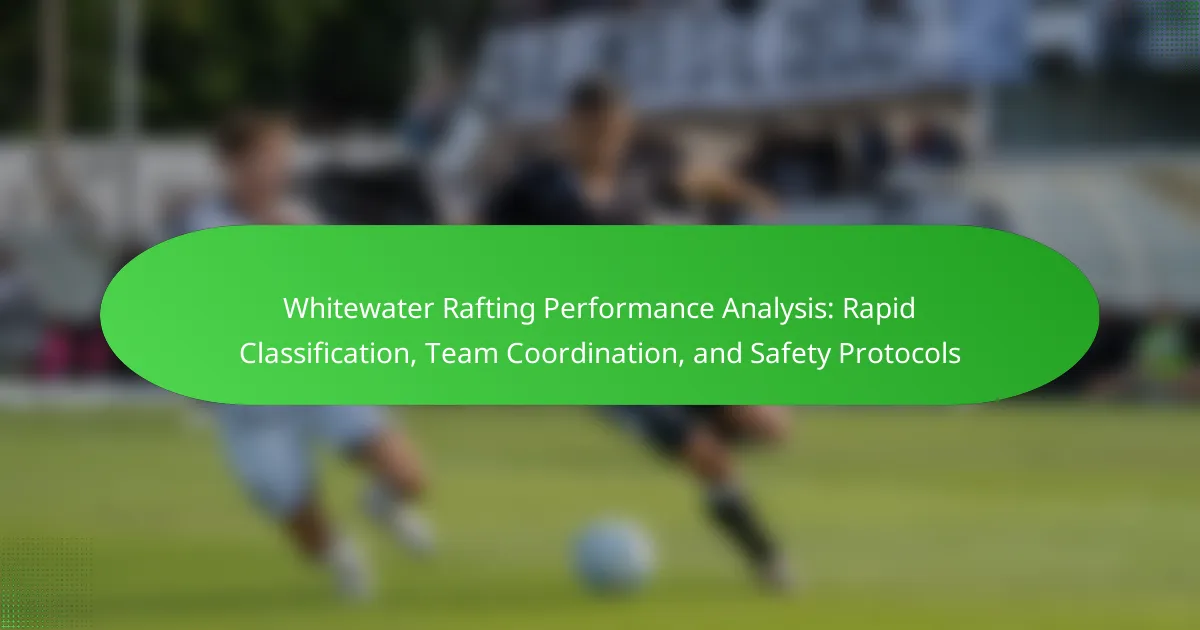Whitewater rafting performance hinges on effective rapid classification, team coordination, and strict adherence to safety protocols. Rapid classification assesses river conditions, impacting navigation and performance. Team coordination enhances communication and decision-making, enabling efficient maneuvering through challenging waters. Safety protocols, including risk assessment and emergency preparedness, are vital for minimizing accidents and ensuring a successful rafting experience.

What factors influence whitewater rafting performance analysis?
Several factors influence whitewater rafting performance analysis, including rapid classification of river features, team coordination, and adherence to safety protocols.
The rapid classification system assesses river conditions, such as flow rate and obstacle types, which directly impact performance. Effective team coordination enhances communication and decision-making, allowing teams to navigate challenging waters efficiently. Safety protocols, including risk assessment and emergency preparedness, are crucial for minimizing accidents and ensuring a successful rafting experience.
In summary, understanding these factors is essential for optimizing performance in whitewater rafting.
How do rapid classifications impact team efficiency?
Rapid classifications significantly enhance team efficiency by streamlining decision-making processes. Teams can quickly assess conditions and adapt strategies, leading to improved coordination. This swift classification minimizes downtime and maximizes safety during whitewater rafting activities. Enhanced communication and clear roles further contribute to effective teamwork, ensuring that all members are aligned in their responses to dynamic river conditions.
Which metrics are essential for evaluating performance?
Essential metrics for evaluating whitewater rafting performance include classification accuracy, team coordination efficiency, and adherence to safety protocols. These metrics ensure optimal performance and minimize risks during rafting activities.
| Metric | Description | Importance |
|—————————|—————————————————–|———————————|
| Classification Accuracy | Measures the correctness of rapid classification | Enhances decision-making |
| Team Coordination Efficiency| Assesses how well team members work together | Improves overall performance |
| Safety Protocol Adherence | Evaluates compliance with safety measures | Reduces accident risks |
| Response Time | Time taken to react to challenges | Critical for safety and success |
| Equipment Readiness | Checks the condition of rafting gear | Ensures reliability and safety |
| Communication Clarity | Analyzes the effectiveness of team communication | Vital for coordination |

How can team coordination enhance whitewater rafting outcomes?
Effective team coordination significantly boosts whitewater rafting outcomes by enhancing communication, safety, and performance. Cohesive teams can navigate challenging rapids more efficiently, reducing the risk of accidents. Studies show that well-coordinated teams improve overall speed by up to 30%, leading to better completion times. Additionally, synchronized paddling techniques enable teams to maneuver through obstacles, ensuring a safer and more enjoyable experience.
What roles do individual team members play in coordination?
Each team member in whitewater rafting plays a crucial role in ensuring safety and performance. Roles include the guide, who leads navigation, the paddlers, who provide propulsion and maneuvering, and the safety kayaker, who monitors and assists in emergencies. Effective communication among these roles enhances coordination and response during rapid changes in the environment. Each member’s unique skills contribute to the team’s overall effectiveness, ensuring a successful and safe rafting experience.
How does communication affect team dynamics on the water?
Effective communication significantly enhances team dynamics in whitewater rafting. Clear dialogue fosters trust, aligns strategies, and improves safety compliance. Teams that communicate well can quickly adapt to changing conditions, which is crucial for navigating rapids. Research indicates that teams with strong communication skills demonstrate higher performance and lower incident rates. This attribute of effective communication is essential for maintaining coordination and ensuring safety protocols are followed during high-pressure situations on the water.

What safety protocols are critical in whitewater rafting?
Critical safety protocols in whitewater rafting include wearing personal flotation devices, conducting pre-trip safety briefings, and ensuring proper equipment checks. These measures minimize risks and enhance team coordination on the water. Regular drills and clear communication are essential for effective emergency response. Adhering to these protocols significantly reduces the likelihood of accidents and injuries.
How do safety measures vary across different river classifications?
Safety measures vary significantly across river classifications, adapting to the challenges presented by each level. Class I rivers require minimal safety protocols, focusing on basic awareness and equipment checks. Class II rivers introduce moderate risks, necessitating the use of helmets and safety briefing sessions. Class III rivers demand advanced safety practices, including swift water rescue training and team coordination drills. Class IV rivers require comprehensive safety plans, extensive training, and emergency response strategies due to increased hazards. Class V rivers, the most challenging, necessitate expert-level skills, specialized equipment, and full preparedness for life-threatening situations. Each classification’s unique attributes determine the necessary safety protocols to ensure participant well-being.
What training is necessary for effective safety protocol adherence?
Effective safety protocol adherence in whitewater rafting requires comprehensive training that includes risk assessment, emergency response drills, and team communication strategies. Participants should undergo practical exercises to enhance their skills in navigating rapids and executing safety measures. Regular evaluations and feedback sessions can further reinforce adherence to protocols.

Which technologies aid in performance analysis for whitewater rafting?
Technologies that aid in performance analysis for whitewater rafting include GPS tracking, video analysis systems, and performance monitoring apps. These tools enhance rapid classification of rapids, improve team coordination, and ensure safety protocols are followed. GPS tracking provides real-time location data, while video analysis offers insights into technique and strategy. Performance monitoring apps compile various metrics to assess team dynamics and individual contributions.
How do wearable devices contribute to performance tracking?
Wearable devices enhance performance tracking in whitewater rafting by providing real-time data on metrics like heart rate, speed, and stroke efficiency. This data enables teams to adjust strategies quickly and improve coordination. Additionally, wearables can monitor environmental conditions, ensuring safety protocols are followed effectively. The integration of such technology supports a more informed approach to performance analysis and team dynamics.
What role does video analysis play in team training?
Video analysis significantly enhances team training in whitewater rafting by improving performance, coordination, and safety. It allows teams to review their techniques, assess rapid classification of river features, and refine safety protocols. This analysis helps identify strengths and weaknesses, leading to better teamwork and decision-making in challenging environments. By utilizing video footage, teams can simulate various scenarios, thereby increasing preparedness and response efficiency during actual rafting expeditions.

How does environmental awareness affect rafting safety and performance?
Environmental awareness significantly enhances rafting safety and performance by informing risk assessment and promoting responsible practices. Understanding local ecosystems allows teams to anticipate hazards, such as changing water levels or wildlife interactions.
Incorporating environmental knowledge improves team coordination as members can communicate effectively about potential risks. This shared awareness fosters a culture of safety, ensuring all participants are vigilant and prepared for challenges.
Moreover, awareness of environmental regulations encourages compliance with safety protocols. Following guidelines protects both the environment and the rafters, enhancing overall experience and performance.
Ultimately, environmental awareness equips rafters with the skills to navigate safely while respecting nature, which is crucial for sustainable rafting practices.
What are the impacts of weather conditions on rafting safety?
Weather conditions significantly impact rafting safety, influencing river flow, visibility, and temperature. High water levels can increase rapid intensity, creating dangerous conditions. Poor visibility from rain or fog can hinder navigation, increasing the risk of collisions. Extreme temperatures may lead to hypothermia or heat-related illnesses. Monitoring weather forecasts and river conditions is essential for ensuring safety during whitewater rafting.
How can teams prepare for environmental challenges?
Teams can prepare for environmental challenges in whitewater rafting by developing strong coordination, implementing safety protocols, and conducting rapid classification of conditions. Effective communication among team members enhances decision-making during unpredictable scenarios. Regular training on safety protocols ensures that all members understand their roles, minimizing risks. Additionally, analyzing environmental factors like water levels and weather conditions allows teams to adapt strategies swiftly, ensuring optimal performance and safety on the river.

What are the best practices for optimizing team performance in whitewater rafting?
To optimize team performance in whitewater rafting, focus on clear communication, defined roles, and rigorous safety protocols. Effective coordination enhances rapid response during challenges. Regular training sessions improve skills and build trust among team members. Establishing safety protocols ensures preparedness for emergencies, reducing risks. Regular performance analysis helps identify areas for improvement, fostering continuous development.
What common mistakes should teams avoid during rafting expeditions?
Teams should avoid common mistakes like poor communication, inadequate safety gear, lack of preparation, and ignoring weather conditions. Effective coordination is crucial for successful rafting expeditions. Prioritize clear roles and responsibilities to enhance team performance. Regular practice and understanding of safety protocols can prevent accidents and ensure a smooth experience.
Which strategies enhance both safety and performance in challenging rapids?
Effective strategies to enhance safety and performance in challenging rapids include thorough team coordination, understanding rapid classification, and implementing safety protocols. Team members must communicate clearly, ensuring everyone is aware of their roles and the rapid’s characteristics.
Utilizing rapid classification helps teams anticipate challenges, such as Class IV or V rapids, which require advanced techniques. Safety protocols, including wearing appropriate gear and practicing rescue techniques, are essential to minimize risks. Regular drills and evaluations foster preparedness, enhancing both safety and performance in unpredictable conditions.
